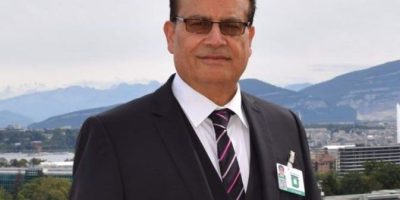The Reality and Rhetoric Pezeshkian’s Foreign Policy

Dr. Muhammad Akram Zaheer
In the initial weeks of his presidency, Iranian President MasoudPezeshkian has demonstrated a cautious approach to foreign policy, opting to align his actions with established regime rhetoric rather than advancing the bold initiatives he championed during his electoral campaign. This hesitancy contrasts sharply with the expectations set by his campaign, where he vocally criticized Tehran’s growing international isolation and pledged to restore Iran’s global standing through more pragmatic and constructive diplomatic engagements.
Pezeshkian’s campaign rhetoric resonated with a populace weary of the socio-economic repercussions stemming from Iran’s strained international relations, particularly in the wake of U.S. sanctions and the protracted negotiations surrounding the Joint Comprehensive Plan of Action (JCPOA). His promises of a shift towards a more balanced foreign policy approach, one that could potentially ease Iran’s isolation and improve its economic conditions, garnered significant attention and support. However, since assuming office, Pezeshkian’s foreign policy actions have largely mirrored the hardline positions traditionally upheld by the Islamic Republic’s leadership, raising questions about his ability or willingness to fulfill his campaign promises. The continuity in foreign policy under Pezeshkian’s administration can be attributed to several factors. Firstly, the president’s office, while influential, operates within the broader framework of the Islamic Republic’s political system, where the Supreme Leader holds ultimate authority over key foreign policy decisions. This structural reality inherently limits any president’s ability to enact significant changes, particularly when such changes might diverge from the established ideological and strategic imperatives of the regime. Pezeshkian’s adherence to regime slogans suggests a recognition of these limitations and a strategic choice to avoid confrontation with more powerful elements within the state, including the Supreme Leader and the Islamic Revolutionary Guard Corps (IRGC).
Secondly, Pezeshkian’s cautious stance may reflect a pragmatic assessment of the international environment. The geopolitical context in which Iran operates is fraught with challenges, including ongoing tensions with the West, particularly the United States and complex relations with regional powers like Saudi Arabia and Israel. In such a volatile environment, Pezeshkian may have concluded that a more cautious approach, one that aligns with the regime’s established positions, would be more sustainable in the short term. This approach allows him to consolidate power internally and avoid exacerbating external pressures during a period of significant uncertainty. However, Pezeshkian’s reticence to deviate from established foreign policy positions has disappointed those who hoped his presidency would mark a departure from the status quo. The disconnect between his campaign rhetoric and his early actions in office has led to growing skepticism about his capacity to implement the reforms necessary to reduce Iran’s international marginalization. As his presidency progresses, Pezeshkian will likely face increasing pressure both domestically and internationally to clarify his foreign policy agenda and demonstrate a more proactive stance in addressing Iran’s diplomatic challenges.
In the complex political landscape of Iran, Ali Pezeshkian, a prominent figure within the reformist camp, is acutely aware of the limitations imposed upon his influence by the supreme authority of Ayatollah Ali Khamenei. The Iranian political system, characterized by a theocratic hierarchy with Khamenei at its apex, does not easily lend itself to the imposition of agendas that deviate from the established ideological and strategic doctrines of the state. Pezeshkian’s recognition of this reality is crucial, as it underscores the need for a more nuanced approach in navigating the corridors of power in Tehran. Pezeshkian’s strategy, therefore, does not involve directly challenging the authority of Khamenei or the Revolutionary Guards, the latter being a formidable military and political force that often aligns closely with the Supreme Leader’s vision. Instead, his approach appears to be centered on persuasion, a method that, while subtle, could potentially yield significant results if executed with strategic acumen. Persuasion in this context would require Pezeshkian to frame his arguments in a way that resonates with the core concerns of the Iranian leadership, particularly regarding national security, regional influence and the preservation of the Islamic Republic’s ideological integrity.
The notion of advocating for a less confrontational posture toward the outside world, as Pezeshkian might propose, would necessitate a careful balancing act. On one hand, it would involve articulating the potential benefits of reducing tensions with the international community, such as economic relief from sanctions, improved diplomatic relations and greater stability in the region. On the other hand, it would require addressing the deep-seated mistrust that has historically characterized Iran’s interactions with the West, particularly with the United States and its allies. For Pezeshkian to succeed in persuading the Supreme Leader and the Revolutionary Guards, his arguments would need to align with the strategic interests of the state. This could involve emphasizing how a less antagonistic foreign policy might enhance Iran’s long-term security by preventing the formation of hostile coalitions against it, thereby allowing the country to consolidate its regional influence without overextending its resources. Additionally, he could argue that a reduction in external tensions might provide the Revolutionary Guards with the space to focus on internal development projects, which could enhance their domestic legitimacy and economic power. However, Pezeshkian’s task is complicated by the ideological foundations of the Islamic Republic, which have long been defined by resistance to Western influence and a commitment to exporting the Islamic Revolution. Any suggestion of softening this stance could be perceived as a threat to the very identity of the state. As such, Pezeshkian would need to navigate these ideological sensitivities with care, possibly by framing his proposals not as a departure from the revolutionary principles but as an evolution of them, adapted to the current global realities.
While Pezeshkian cannot impose his agenda on Khamenei or the Revolutionary Guards, his potential to persuade them lies in his ability to present a less confrontational posture as a strategic necessity rather than a compromise. By aligning his proposals with the broader goals of the state and addressing, the core concerns of its leadership, Pezeshkian may find a receptive audience for his vision of a more diplomatically engaged Iran.
Related News

How India Backstabbed Iran
By Qamar Bashir In the geopolitical arena of South and West Asia, trust is oftenRead More

Depalpur: An Ancient Kingdom
Afshan Kanwal Student BS BBIT University of Okara Depalpur is one of the most ancientRead More


Comments are Closed